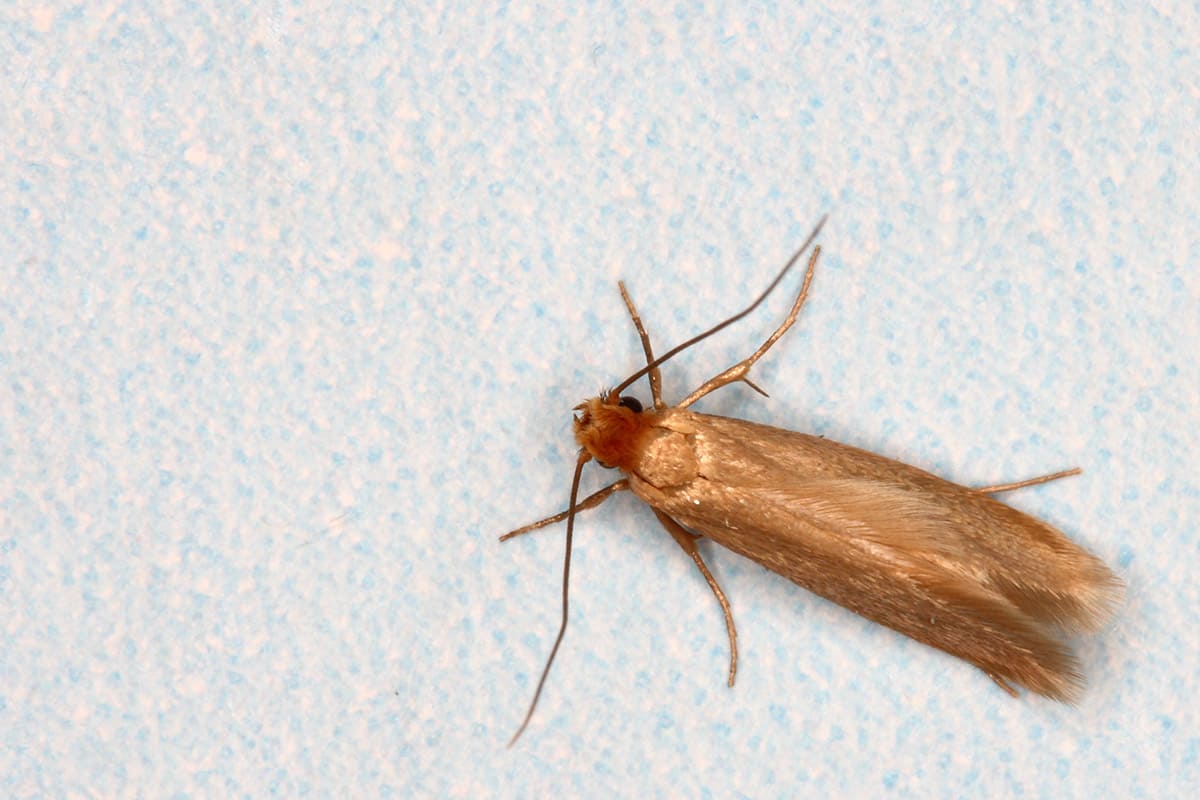Have you ever taken woolen clothes out of storage for wintertime and discovered that they’d been moth-eaten? If you’re anything like me, you’ve probably offered some pretty colorful profanity in response. Fortunately, there’s good news: there are easy ways to fend off clothes moths, so they don’t eat your longjohns.
What are Clothes Moths?
There are two main types of clothes moths that like to nom on our outfits. There is the webbing clothes moth (Tineola bisselliella):
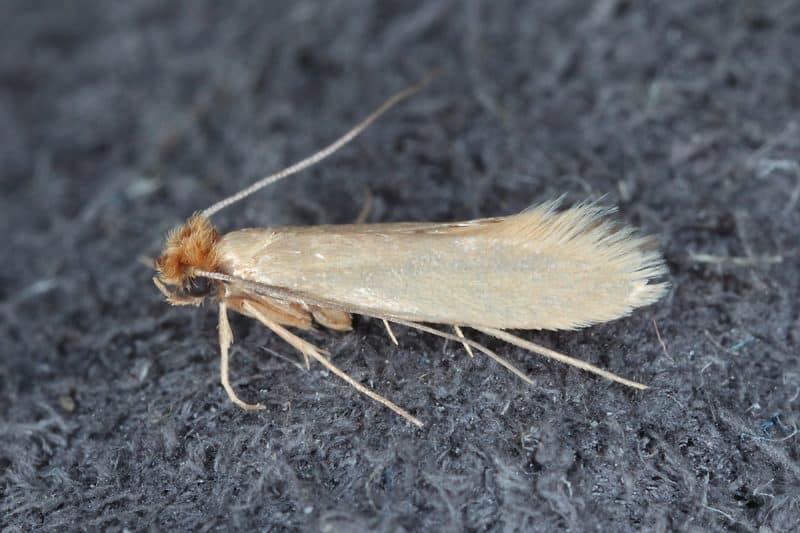
The other is the casemaking clothes moth (Tinea pellionella):
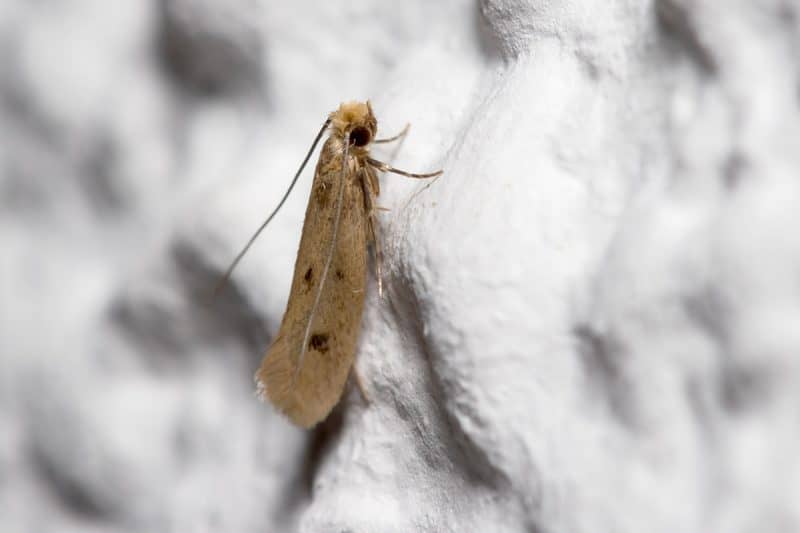
Both species avoid light, which is why they like to burrow down into comfy piles of fabric to hide and breed in.
Furthermore, they both prefer to eat wool or wool blend fabrics. In a pinch, they’ll also devour furs and feathers, as well as cotton or linen.
Interestingly, they prefer to chow down on clothes that have recently been worn. Maybe sweat, and skin cells offer a particularly fun flavoring for them. This is probably why they’ll also gravitate towards hair (both human and pet) that has accumulated in dark corners. Ew.
Signs of Clothes Moth Infestations
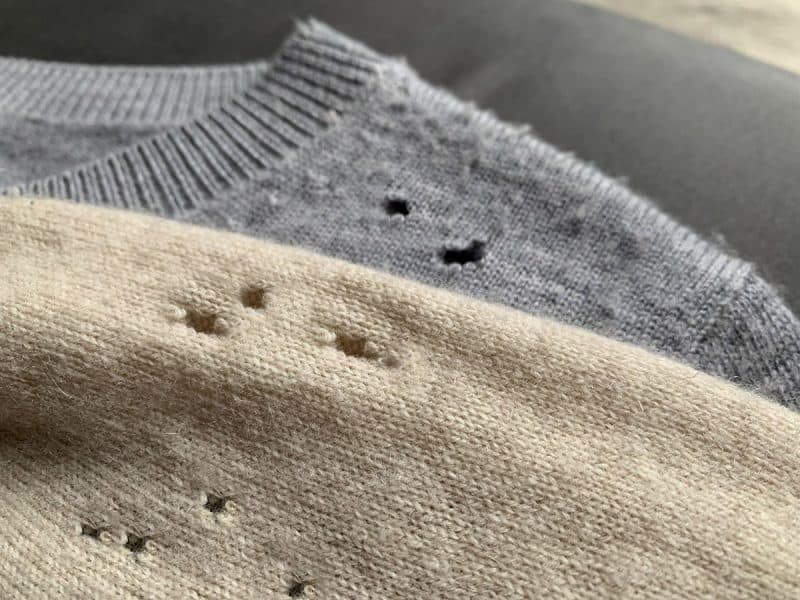
The main way to tell that you’re dealing with clothes moths is that there are big chunks that have been chewed out of your woolens. Many people only discover this kind of damage when they take heavy coats and warmer clothes out of storage in autumn. Then they’ll see the telltale powdery casings clinging to the fabric and the holes bitten through everything.
These moths leave spidery filaments in their wake, along with their aforementioned powdery chrysalis husks. Depending on what point of their development cycle you discover their presence, you may also find streaks of tiny white eggs between fabric folds.
These eggs hatch in three to eight days, and the larvae that spill out are voracious. If you’ve only ever had mild moth damage on your clothes, count yourself lucky! You wouldn’t believe what these things can annihilate if you don’t catch an infestation on time.
How to Deter These Species
Although clothes moths are really annoying pests to deal with, you can actually deter them fairly easily. They have acute olfactory senses, so certain scents will encourage them to fly elsewhere in search of sustenance.
1. Cedar
Did your grandparents own cedar chests? Most older generations did, and they used them religiously to store woolen blankets, sweaters, and other cold-weather gear. This is because moths can’t stand the scent of cedar and will avoid it at all costs.
If the high cost of good cedar chests is off-putting, no need to fret. You can buy cedar balls and just pop them into your dresser drawers. Get yourself a bottle of high-quality cedar essential oil, and just re-scent the balls once a month.
2. Lavender
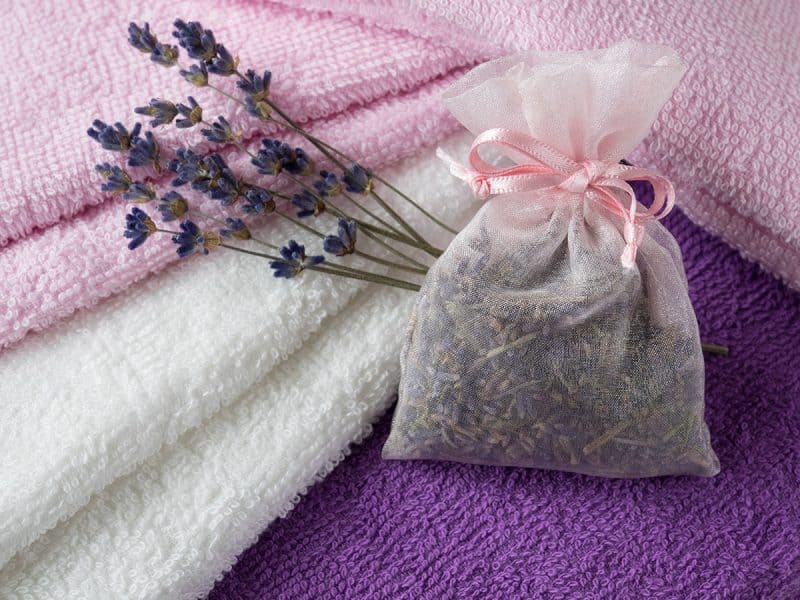
Although cedar is well known for keeping clothes moths at bay, lavender also has a good track record for doing the same. Apparently, that’s something these moths and I have in common: we can’t stand the scent of lavender and will avoid it whenever possible.
Fill little burlap or organza bags with lavender flowers to make sachets. Then tuck these quite liberally in amongst your dresser drawers. Hang them in closets, and tuck them into shoes as well.
Just ask your partners and children first before assaulting their olfactory systems with this stuff. Most men don’t want to smell like lavender all day, and many children find the scent overpowering as well. If this is the case, stick with the cedar balls.
3. Additional Scents
If you live in a household where people can’t stand either lavender or cedar (or are allergic to them), there are a few other options you can use. These essential oils have insect-repelling properties and can also help to repel moths. You can diffuse their scent into the closet, infuse wood or fabric sachets with them, or create scented sprays.
The latter is a great option, as you can just mix them with water and spritz a bit into drawers and closets once a week.
- Rosemary: Since most insects dislike this scent, moths will try to avoid areas where it’s found. Make sachets with dried rosemary, or hang bunches in closets.
- Camphor: Will make you smell like you’ve been slathered in VaporRub or Tiger Balm, but is remarkably effective at repelling just about any insect. Humans too, just FYI.
- Lemon: This is a great alternative for people who can’t abide lavender. Moths dislike citrus scents, and lemon in particular will often send them packing. Also, lemon-scented clothes smell divine.
- Citronella: Another citrus scent that works well to fend off moths, as well as mosquitoes and flies.
- Cinnamon: This scent is quite powerful, but effective at keeping flying vermin at bay.
- Peppermint: Both moths and mice despise the scent of peppermint, so infusing wood or sachets with the essential oil will keep both of them out of your closets. And you’ll smell like peppermint ice cream, so there’s a bonus.
How to Deal with an Infestation of Clothes Moths
Once you’ve finished tearing around the house, shrieking, it’s time to get to work. You’ll need to destroy any moth eggs that may be waiting to hatch, as well as larvae that may be already lurking in the fabrics.
What You’ll Need:
- Plastic garbage bags
- Rubber or latex gloves
- Bucket of hot, soapy water (lavender Castile soap works well)
- Rags or sponges for scrubbing
- Caulking (and a caulking gun)
- Palette knife or spatula
- Wool-safe laundry detergent
- Plastic storage containers (expanded upon later)
Put on the gloves, take absolutely everything out of the closet, dresser, etc., where you found the moth, and pack it all into those garbage bags. Then take that hot, soapy water and wash every surface, nook, and cranny.
Allow the area to dry completely, and then grab that caulking gun. Use the caulk to seal up cracks, crevices, and holes in and around the area. These nooks are where moths like to hide when they’re not laying eggs and eating your clothes.
Seal up cracks beneath baseboards and gaps up along crown molding, as they’re known hiding spots. Use the spatula or palette knife to scrape away any excess.
Once that’s done and drying, wash everything in those bags according to their care directions. This will probably take a while, especially if you have delicates that need to be hand-washed. Similarly, some items can only be dry cleaned, like heavy winter coats. Tell the staff at the laundromat that you had moth damage, so they’ll take extra care when handling your stuff.
Secure Storage
After you’ve put all that effort into cleaning and washing, you’ll want to ensure that you don’t have to go through that kind of trauma again any time soon. One of the best ways to ensure that these clothes moths won’t continue to eat their way through your stuff is to store items as securely as possible.
For example, you know those zippered plastic bags that bedding sets come in? Save those, and use them for your wool/blend clothes and blankets. Make sure to wipe them out thoroughly before storing anything in them, just in case of moth eggs. Then dry clean (or safely launder) your items, fold them neatly, and zip them into these bags.
Similarly, you can get zippered plastic garment bags for woolen coats. Store your outwear clothing items in these whenever you’re not actively using them. Then zip them closed so moths can’t sneak in when you’re not looking. Keep mittens, gloves, and socks in plastic bags or containers, with those lavender or cedar sachets, tucked in amongst them.
Keep Craft Supplies in Airtight Containers Too!
In addition to keeping your woolen clothes and bedding safe, be sure to keep your craft supplies secure as well. It’s heartbreaking to put a ton of time and effort into spinning, weaving, and knitting items only to find them with holes munched through them months later. I once lost a lace shawl to a moth infestation after spending close to half a year knitting it, so I feel the pain here.
Wool roving that’s used for spinning yarn is particularly susceptible to moth damage. Furthermore, it sometimes even arrives with moth eggs in it. If you can, wash wool roving (including a period of vinegar soaking) and let it dry thoroughly. Once it’s fully dry, you can roll it up gently for secure storage. This should kill off any moths—and eggs—that may be lurking within.
Pack your supplies into plastic zipper bags, and place those in a large seal-able container. Before locking the top on, toss some of those scented cedar balls in for good measure.
Avoid Using Chemicals
These moths may be a nuisance, but they’re not harmful to anything other than your clothing. Try to avoid using toxic pesticides like sprays or mothballs to repel them. This is because these chemicals can be harmful to your family and animal companions.
In fact, mothballs can be downright deadly to cats and dogs, as well as smaller animals. If you have small humans or animals in the house at all, please avoid these at all costs.
Some diligence with keeping clothes clean, plus essential oil-infused deterrents should keep moths out of your blankets and clothes from here on in.
